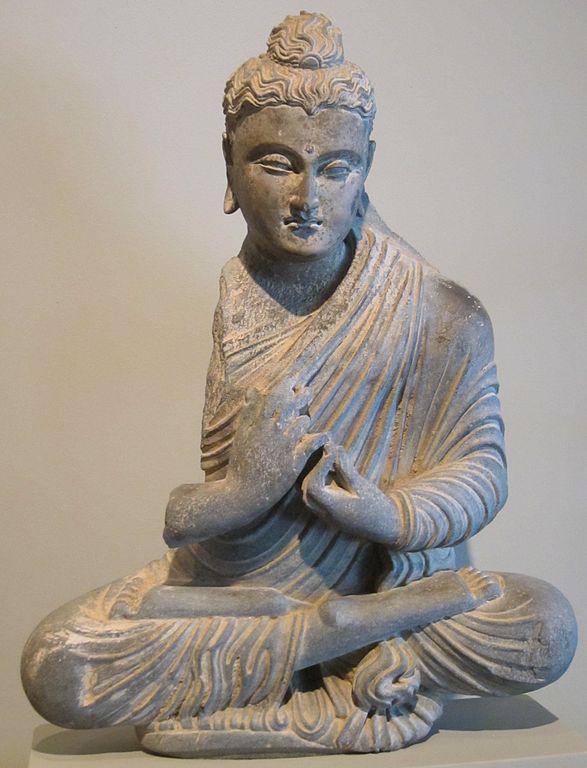On the “third-nature” – II
In the previous post in this series, I examined the representation of non-normative sexualities and gender presentations in the Code of Manu and the Kamasutra. This time, it is the turn of ‘queer’ Buddhist anxieties. Again, this is an expansion of a Twitter thread earlier in the year.
Early Buddhist attitudes to sexuality, gender, and desire have come under increasing scrutiny in the last couple of decades, so there’s a wealth of material available and much debate going on. There’s been a rise in LGBTQI Buddhist Sanghas and much talk of “Queer(ing) Buddhism”. Caveat: this isn’t really a field I’m very strong in, so please, anyone more familiar with this material is welcome to comment and correct any errors on my part.
Early Indian Buddhist texts contain a welter of terms to describe those people who exhibit unusual sexual behavior or characteristics, ranging from biological and gender presentations, and what we might nowadays interpret as psychological dispositions. I’m going to focus primarily on one of these terms – the paṇḍaka, and its appearance in the early monastic disciplinary corpus of the Vinayas. The term “paṇḍaka” is slippery to grasp. It is sometimes translated as queer in the sense that queer is an unstable category, as opposed to a synonym for same-sex-desiring, dispositionally-oriented persons. Consulting various books, I’ve seen paṇḍaka translated as ‘neuter’ or ‘eunuch’, homosexual, or ‘deviant’. José Ignacio Cabezón’s translation of paṇḍaka as ‘queer’ seems to me to cover all the bases. There is still an argument as to what is at the core of the paṇḍaka’s deviant status. I’ll get into that shortly.
The paṇḍaka appears in both the Pāli and the Mūlasarvāstivāda Vinayas. The Vianayas is a corpus of texts (thought to have been set down in the 1st-century BCE – but probably much older) that set down the prescriptive rules for the behavior of Buddhist monks and nuns in their communities. All kinds of sexual acts are frowned upon – some more than others.
In the Pāli Vinaya, there is the tale of the paṇḍaka who has been ordained as a monk. He approaches a group of young monks and invites them to “defile yourselves with me”. They refuse. He approaches a group of older novices and makes the same offer. They also refuse him. He then approaches a group of elephant and horse owners (they are not ordained Buddhists, but more like support staff) and they submit to his wiles. But afterward, they become angry and say that all the Buddhist ascetics are paṇḍakas, and even if they are not, they “defile themselves” with paṇḍakas. Thus they are all immoral.
The Buddha, on hearing this from the aggrieved monks, is said to have responded thusly:
“A paṇḍaka, monks, (if) not ordained, should not receive ordination, and (if) he is ordained, he should be expelled.”
A commentary by Buddhaghosa (5th-century CE) provides an expanded typology of the paṇḍaka:
- The napuṃsakapaṇḍaka – “not male”, is a congenital state, perhaps indicating asexuality. 1
- The usūyapaṇḍaka, whose lust is aroused by viewing the sexual transgressions of others.
- The pakkhapaṇḍaka – the fortnight-paṇḍaka, whose “fever of lust” occurs during the dark half of the month, i.e. full moon to new moon. 2
- The āsittapaṇḍaka/āsekapaṇḍaka performs oral sex with other males.
- The oppakamikapaṇḍaka, whose ‘seeds’ (testicles) have been removed, perhaps through medical remedies.
Buddhaghosa says of the paṇḍaka:
“They are filled with defiling passions (kilesā), their lust is not calm, and they lack masculinity (napuṃsaka). Overcome by the force of their lust, they desire friendship with anyone”.
As can be seen from the above, the term paṇḍaka includes both physical conditions, desires, and actions. Hence it’s ‘queerness’ as a term neither grounded in gender identity nor sexual orientation.
One might think that persons deemed incapable of experiencing sexual desire would make ideal ascetics, but this is not the case. Buddhist practices center around restraint, and paṇḍakas were routinely denigrated because they were deemed to be incapable of restraint. The incapacity to experience sexual desire makes restraint practices redundant, and thus such a person will obtain no benefit from them. At least, that’s how I understand it. At the same time though, paṇḍakas were portrayed as hypersexual – having an excess of lust compared to normal persons, and again, lacking the capacity for restraint and spiritually incapable of acquiring it. The Milinda Pañha (Debate of King Milinda, 100 BCE-200 CE) lists paṇḍakas amongst those categories of people who are deemed incapable of grasping the Dharma, and the Lotus Sūtra states that paṇḍakas should not be preached to.
There’s also a concern not only about paṇḍakas themselves, but also about them tempting ordained Buddhists to sin, and notably, on what the rest of society thinks. The idea that outwardly ascetic Buddhists were secretly lovers of luxury and indulged in dissolute pleasures was quite widespread (see this blog post for some related discussion).
Over time, the term paṇḍaka became a kind of catch-all term that was applied to a wide range of behaviors, gender presentations, and sexed bodies which were deemed non-normative. There is mention of female paṇḍakas (itthipaṇḍakā) for instance.
In the next post, I’ll take a quick dive into early Āyurvedic literature.
Sources
Allan R Bomhard. 2016. The Two Meanings of the Pāḷi Term paṇḍaka. Link.
José Ignacio Cabezón. 2017. Sexuality in Classical South Asian Buddhism. Wisdom Publications.
Janet Gyatso. 2003. One Plus One Makes Three: Buddhist Gender, Monasticism and the Law of the Non-Excluded Middle. History of Religions, Vol.43, No.2 (November 2003), pp89-115. Link.
Janet Gyatso. 2005. ‘Sex’ in Donald S. Lopez Jr (ed). Critical Terms for the Study of Buddhism. The University of Chicago Press.
Bee Scherer. 2021. Queering Buddhist Traditions. Link.
Notes:

